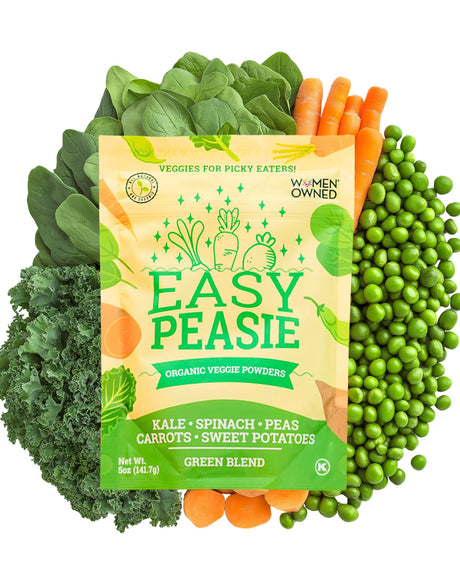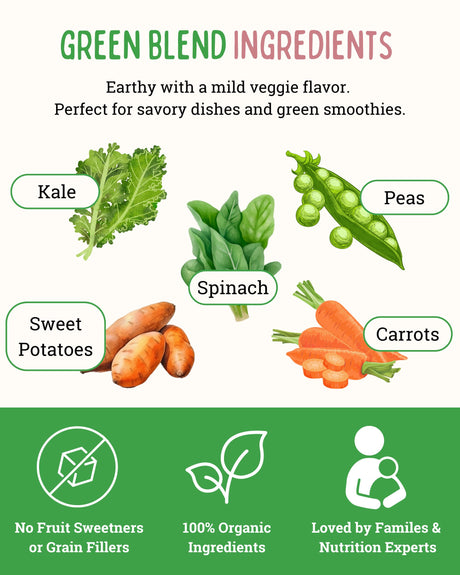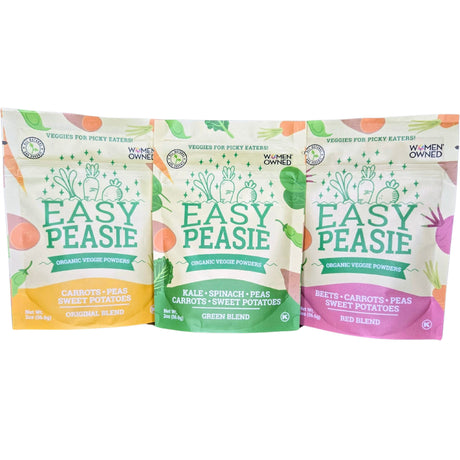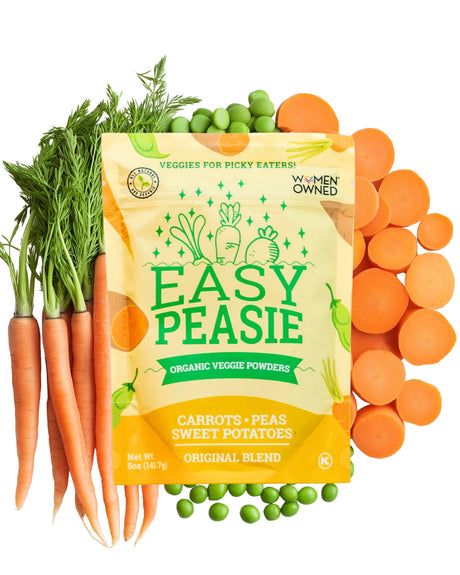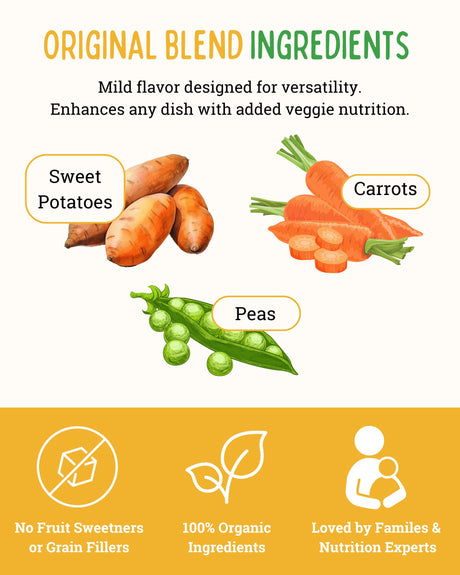You've been dealing with your child's limited diet for months, but lately you've noticed something concerning: they're straining during bowel movements, complaining of tummy aches, and seem uncomfortable after meals. What started as picky eating has evolved into a cycle where digestive discomfort makes them even more reluctant to try new foods.
If this sounds familiar, you're not alone. The connection between picky eating and constipation is more common than many parents realize, and it creates a frustrating cycle that can feel impossible to break. When children eat limited variety – often favoring processed foods over fruits and vegetables – their digestive systems struggle to function properly.
The encouraging news is that understanding this connection gives you the power to address both issues naturally. By focusing on gentle, strategic approaches to increase fiber and improve digestive health, you can help your child feel more comfortable while gradually expanding their food acceptance. The key is working with your child's current preferences while slowly building toward better digestive and nutritional health.
Understanding the Picky Eating-Constipation Connection
How Limited Diets Lead to Digestive Issues
When children eat primarily processed foods, refined grains, and dairy products while avoiding fruits and vegetables, their digestive systems don't get the fiber and nutrients needed for healthy function. This creates a perfect storm for constipation, which then makes children feel uncomfortable and even less willing to try new foods.
The typical picky eater's diet often includes foods like white bread, pasta, crackers, cheese, and milk – all of which are low in fiber and can contribute to sluggish digestion. Meanwhile, the foods that support healthy bowel movements – fruits, vegetables, and whole grains – are exactly the ones most picky eaters refuse.
Common Constipation-Promoting Foods in Picky Diets:
- White bread and pasta
- Processed snack foods
- Excessive dairy products
- Refined cereals
- Chicken nuggets and other processed proteins
The Vicious Cycle Explained
Constipation creates physical discomfort that makes children associate eating with feeling bad. When they're already uncomfortable from poor digestion, they become even more selective about foods, often gravitating toward familiar options that won't upset their already sensitive systems.
This leads to a cycle where limited eating causes digestive issues, which then reinforces food avoidance and selectivity. Children may refuse foods not because of taste or texture preferences, but because they've learned that eating sometimes makes them feel worse.
The Cycle Looks Like This:
- Limited diet lacks fiber and variety
- Constipation develops from inadequate fiber intake
- Child feels uncomfortable and associates discomfort with eating
- Food selectivity increases as child avoids anything that might cause discomfort
- Diet becomes even more limited, worsening digestive issues
Physical Signs to Watch For
Many parents don't immediately connect their child's digestive issues with their eating patterns. Recognizing the signs of constipation can help you understand whether digestive health is playing a role in your child's food refusal.
Signs of Constipation in Children:
- Fewer than three bowel movements per week
- Hard, dry, or pellet-like stools
- Straining or pain during bowel movements
- Complaints of stomach pain or bloating
- Loss of appetite
- Irritability or mood changes
- Accidents after being potty trained
Why Fiber Matters More Than You Think
Fiber is crucial for healthy digestion, but it's often the most missing component in picky eaters' diets. Fiber helps move food through the digestive system, softens stools, and feeds beneficial gut bacteria that support overall health.
Most children need 15-25 grams of fiber daily, but picky eaters often consume less than half this amount. When children consistently eat low-fiber diets, their digestive systems become sluggish, creating the discomfort that perpetuates picky eating behaviors.
Natural Approaches to Breaking the Cycle
Starting Where Your Child Is
The key to breaking the constipation-picky eating cycle is meeting your child where they are nutritionally while gradually improving their fiber intake. This means finding ways to add digestive support to foods they already accept rather than immediately trying to introduce high-fiber foods they're likely to refuse.
This approach reduces the pressure on both you and your child while still addressing the underlying digestive issues that may be driving some of their food selectivity.
Strategic Fiber Additions
One of the most effective ways to improve your child's fiber intake is through strategic additions to foods they already eat. This might mean choosing higher-fiber versions of familiar foods or finding creative ways to incorporate fiber-rich ingredients into accepted meals.
Simple Fiber Upgrades:
- Switch to whole grain pasta gradually (start with half white, half whole grain)
- Choose higher-fiber cereals or mix them with familiar low-fiber options
- Add ground flaxseed to yogurt or smoothies
- Include pureed beans in pasta sauce or soups
- Choose whole grain crackers over refined versions
Strategic Vegetable Nutrition
For severely limited eaters, vegetable powders can provide essential fiber and nutrients that support digestive health without requiring immediate acceptance of whole vegetables. When children's diets lack the variety needed for healthy digestion, strategic nutritional support can help break the cycle of discomfort.
Many parents find that when their children's digestive systems start functioning better through improved nutrition, their willingness to try new foods gradually increases. This happens because they no longer associate eating with physical discomfort.
How Vegetable Powders Support Digestion:
- Provide fiber in easily digestible form
- Supply nutrients that support gut health
- Can be mixed into already-accepted foods
- Help establish regular bowel movements
- Create positive associations between eating and feeling good
Easy Peasie Red Blend, which includes beets along with carrots, peas, and sweet potatoes, offers a particularly gentle way to add vegetable nutrition that includes natural fiber. The mild flavor makes it easy to incorporate into familiar foods without changing taste or texture significantly.
Real families have found success with this approach. One parent shared: "My son is so picky but I put this on anything even Ice cream and he doesn't notice what a life saver." Another noted: "The biggest thing I've noticed... is his #2s in the potty. He's had 'rock poos' because of all the junk and dairy he eats. It is looking a lot better! ...he's going to the bathroom easier with the veggie powder."
Hydration: The Missing Piece
While fiber gets most of the attention in discussions about constipation, adequate hydration is equally important. Many picky eaters prefer milk, juice, or sugary drinks over water, which can actually worsen digestive issues.
Hydration Strategies for Picky Drinkers:
- Offer water in fun cups or with straws
- Add natural flavor with cucumber or lemon slices
- Serve room temperature water rather than cold
- Include water-rich foods like melons or oranges when possible
- Limit milk intake to recommended amounts (16-20 ounces daily for toddlers)
Movement and Routine
Physical activity helps stimulate digestion and can be especially helpful for children dealing with constipation. Additionally, establishing regular bathroom routines can support healthy bowel movements.
Gentle Approaches:
- Encourage active play after meals
- Take family walks together
- Establish regular bathroom times (especially after meals)
- Make bathroom time relaxed and unhurried
- Provide a footstool for proper positioning
Practical Implementation Strategies
Week One: Assessment and Gentle Changes
Begin by observing your child's current eating and bathroom patterns without making dramatic changes. Notice which foods they eat regularly and how often they have comfortable bowel movements.
Start with one small change, such as offering water more frequently or switching to a higher-fiber version of one accepted food. The goal is to begin supporting digestion without creating food battles.
Week Two: Strategic Additions
Once you've established baseline observations, begin incorporating fiber-rich additions to accepted foods. This might mean adding a small amount of vegetable powder to pasta sauce or offering a fiber-rich snack alongside familiar options.
Focus on foods that support digestion without overwhelming your child's current acceptance level. Remember that even small improvements in fiber intake can make a significant difference in digestive comfort.
Week Three: Building Consistency
Establish consistent routines around both eating and bathroom habits. Regular meal times help regulate digestion, while consistent bathroom opportunities support healthy elimination patterns.
Continue offering fiber-rich options alongside accepted foods, but avoid pressuring your child to eat them. The goal is consistent exposure while supporting their digestive system through strategic additions to accepted foods.
Working with Specific Challenges
When Children Refuse All Fruits and Vegetables
For children who refuse all fresh fruits and vegetables, finding alternative sources of fiber becomes crucial. Focus on foods they do accept and find creative ways to boost their nutritional and fiber content.
Alternative Fiber Sources:
- Whole grain versions of accepted breads or cereals
- Beans pureed into sauces or soups
- Chia seeds mixed into yogurt or smoothies
- Oatmeal or other whole grain breakfast options
- Vegetable nutrition like Easy Peasie Red Blend added to accepted foods
Dealing with Texture Sensitivities
Many children with severe picky eating have underlying texture sensitivities that make traditional high-fiber foods challenging. In these cases, focusing on smooth, familiar textures while still providing digestive support becomes important.
Texture-Friendly Approaches:
- Smooth vegetable purees mixed into sauces
- Finely ground flaxseed added to familiar foods
- Vegetable powders that don't change texture
- Well-cooked, soft fruits when possible
- Gradually introducing texture variety as digestion improves
Managing Dairy-Heavy Diets
Many picky eaters rely heavily on dairy products, which can contribute to constipation when consumed in excess. While dairy provides important nutrients, balancing intake with fiber-rich foods is essential for digestive health.
Dairy Balance Strategies:
- Limit milk to recommended amounts for your child's age
- Choose yogurt with probiotics when possible
- Ensure adequate water intake separate from dairy consumption
- Add fiber-rich foods to dairy-based meals
- Consider calcium-fortified alternatives if appropriate
Supporting Gut Health Naturally
The Role of Beneficial Bacteria
Healthy gut bacteria play a crucial role in digestion and overall health. When children eat limited diets, they may not get the variety of nutrients needed to support beneficial bacteria growth.
Natural Ways to Support Gut Health:
- Include probiotic foods when accepted (yogurt, kefir)
- Focus on prebiotic foods that feed good bacteria
- Minimize processed foods when possible
- Ensure adequate fiber intake to support bacterial diversity
- Consider age-appropriate probiotic supplements if recommended by healthcare providers
Creating Positive Food Associations
As your child's digestive health improves, it's important to create positive associations between eating and feeling good. This helps break the cycle of food avoidance that often develops when children associate eating with discomfort.
Building Positive Associations:
- Celebrate small improvements in bathroom comfort
- Notice and mention when your child seems to feel good after eating
- Avoid drawing negative attention to digestive issues
- Focus on how foods help their body feel strong and healthy
- Maintain relaxed, positive mealtimes
When to Seek Professional Help
Red Flags That Require Medical Attention
While many cases of constipation can be addressed through dietary changes, some situations require professional medical evaluation.
When to Consult Your Pediatrician:
- Severe abdominal pain
- Blood in stools
- Vomiting associated with constipation
- Complete refusal to use the bathroom
- Significant weight loss
- Constipation that doesn't improve with dietary changes after 2-3 weeks
Working with Healthcare Providers
If your child's constipation is severe or persistent, healthcare providers can offer additional support while you work on dietary improvements. This might include temporary medical interventions alongside nutritional strategies.
Involving Feeding Specialists
For children with severe picky eating combined with constipation, working with feeding specialists can provide additional strategies for expanding food acceptance while addressing digestive health. interventions to provide relief?
- How long should we try dietary changes before expecting improvement?
- Should we consider working with a pediatric nutritionist?
- Are there red flags I should watch for?
Involving Feeding Specialists
For children with severe picky eating combined with constipation, working with feeding specialists can provide additional strategies for expanding food acceptance while addressing digestive health.
Types of Specialists Who Can Help:
- Pediatric nutritionists or dietitians
- Occupational therapists specializing in feeding
- Speech-language pathologists with feeding expertise
- Pediatric gastroenterologists for complex cases
Long-Term Success Strategies
Building Sustainable Habits
The goal isn't just to resolve immediate constipation, but to establish eating and digestive patterns that will support your child's health long-term. This means focusing on sustainable approaches rather than quick fixes.
Gradually increase variety rather than making dramatic changes, focus on foods your child can learn to accept over time, and maintain realistic expectations about the timeline for change.
Celebrating Progress
Breaking the constipation-picky eating cycle often involves slow, incremental progress rather than dramatic changes. Celebrating small improvements helps maintain motivation for both parents and children.
Look for more comfortable bowel movements, increased water intake, acceptance of higher-fiber versions of familiar foods, and reduced complaints of stomach pain.
Maintaining Improvements
Once you've achieved better digestive health and food acceptance, maintaining these improvements requires ongoing attention to both nutrition and eating patterns.
Continue offering variety alongside accepted foods, maintain adequate fiber intake through accepted sources, and preserve positive mealtime environments.
Your Action Plan for Breaking the Cycle
Month One: Foundation Building
Focus on understanding your child's current patterns and making gentle, sustainable changes. Document their eating habits, bathroom patterns, and any complaints of discomfort to establish a baseline.
Month Two: Strategic Intervention
Implement more targeted strategies to improve fiber intake and digestive health. This could include adding concentrated vegetable nutrition to accepted foods or introducing gentle movement routines that support digestion.
Month Three: Expanding Options
As digestive health improves, gradually introduce new food options while maintaining the supports that have been working. Remember that this process takes time, and setbacks are normal.
Moving Forward with Confidence
Understanding Individual Timelines
Every child's journey to breaking the constipation-picky eating cycle looks different. Some children respond quickly to dietary changes, while others need months of consistent support before showing significant improvement.
The most important factor is maintaining consistency with approaches that support both digestive health and gradual food acceptance. Small, sustained changes often lead to more lasting improvements than dramatic interventions.
Trusting the Process
Breaking this cycle requires patience and faith in the process, especially when progress feels slow. Remember that you're addressing both immediate digestive comfort and long-term eating patterns, which takes time to establish.
Focus on providing your child with the digestive support they need while creating positive experiences around food. As their physical comfort improves, their willingness to explore new foods often follows naturally.
Building Family Success
The strategies that help break the constipation-picky eating cycle often benefit the entire family. Focusing on fiber-rich foods, adequate hydration, and positive mealtime environments creates healthier patterns for everyone.
Remember that you're not just solving an immediate problem – you're establishing patterns that will support your child's digestive and nutritional health for years to come. The patience and consistency you invest now pays dividends in your child's long-term relationship with food and their body.
When children feel physically comfortable and aren't dealing with digestive distress, they're naturally more open to food exploration and family meals. Breaking the constipation-picky eating cycle creates space for positive food experiences and gradual expansion of accepted foods, setting the foundation for lifelong healthy eating patterns.
Disclaimer: This article is for educational purposes only and does not constitute medical advice. Always consult with your child's healthcare provider for concerns about constipation, digestive health, or significant changes in eating patterns.


